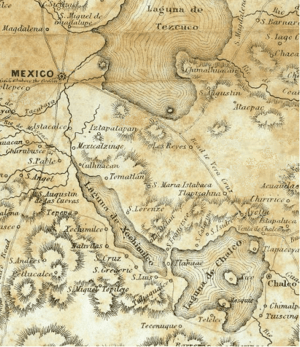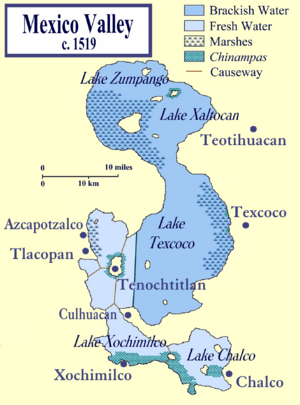Lake Chalco facts for kids
Lake Chalco was a large lake that used to be in the Valley of Mexico. It was very important for the ancient cultures of Mesoamerica, like the Aztecs, who lived in central Mexico. The lake got its name from the old city of Chalco, which was once on its eastern side.
Lake Chalco, along with Lake Xochimilco, was the natural home of the axolotl. This is a special type of amphibian that is now in danger of disappearing because cities have grown and destroyed its habitat.
Contents
Where Was Lake Chalco Located?
Lake Chalco was part of a big system of lakes in the ancient Basin of Mexico. This system included other lakes like Lake Texcoco, Lake Zumpango, and Xaltocan, which had salty water. There was also Lake Xochimilco, which had fresh water, just like Lake Chalco.
These lakes were home to many important Mesoamerican cultures, including the Toltecs and the Aztecs. Lake Chalco had fresh water because of natural springs along its southern shore. This fresh water was perfect for growing crops using a special farming method called chinampas.
How Lake Chalco Changed Over Time
The area around Lake Chalco was very successful in its early history. Unlike the lakes to the north, Lake Chalco had plenty of fresh water and many fish. These things helped the region grow.
Around 500 BC, the Chalco area was one of the most populated places in the Basin of Mexico. About 21,810 people lived there, making it very dense with about 109 people per hectare.
Population Shifts and Chinampa Farming
After the rise of the powerful city of Teotihuacan, the population in Chalco dropped a lot. However, the population grew again around 1400 AD. The number of people per hectare doubled from 75 to 150.
It is believed that chinampas (floating gardens) became widely used in the Chalco and Xochimilco lake beds after 1400 AD. The growth of the Lake Chalco region was likely connected to the increase in chinampa farming.
The Aztec Empire, led by King Itzcoatl, conquered the southern lake region (Chalco and Xochimilco). They used this area to develop chinampa farming even more. The Aztec Triple Alliance needed a lot of food to support the growing city of Tenochtitlan and to control other communities. So, they took over lands that were best for chinampa farming.
While the Triple Alliance farmed other areas, the chinampa zone was ideal for their empire because of the dry conditions elsewhere. During the last years of Itzcoatl’s rule, he built a raised road (causeway) that connected Tenochtitlan to towns near Xochimilco.
Draining the Lake
After the Spanish arrived in the Valley of Mexico, the Aztec system that supported chinampa farming ended. As a result, chinampa production decreased.
Starting in the Aztec era and continuing into the 1900s, people tried to drain Lake Chalco and its sister lakes. This was done to prevent regular flooding and to make room for cities to expand. Today, only a smaller Lake Xochimilco and the Lake of Zumpango still exist.
In the late 1860s, a land investor drained Lake Chalco. This led to a revolt by local farmers (called campesinos) who were organized by Julio López Chávez. The government eventually stopped this revolt.
See also
- Valley of Mexico topics
- In Spanish: Lago de Chalco para niños



